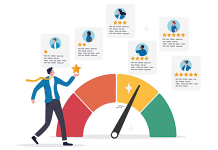
At a time when different work needs to get done — and work needs to get done differently — we leaders have to change. Today, everyone is a leader, and it culminates in how we make others feel.
I had this experience when I was 12 years old, at a basketball camp led by Coach Gene Keady, a legend in Kansas for having earned Junior College Coach of the Year three times while at Hutchinson Junior College. He later went on to an acclaimed coaching career at Division 1 colleges, most notably Purdue, where he served as head coach for 25 years.
Although I was pretty tall and lanky, it was clear I wasn’t destined for the college court, let alone the NBA. But Coach Keady worked with me nonetheless, such as teaching me to dribble to my left. Coach Keady must have seen something else in me. He pulled me aside on the last day of summer basketball camp and said, “Gary, you’re gonna be a leader; never stop believing.”
My miniature “Camper of the Week” trophy, once the centerpiece of my childhood bedroom, is long gone. But the coach’s words have stayed with me all these years — not only for what he said, but how he made me feel.
Empathy leads to action
Through the years I’ve tried, though not always successfully, to make others feel the same, especially now. Empathy is the starting point. It’s the catalyst that turns “we’re all in this together” from only words to a feeling and then an action.
The pandemic will create a seismic shift in an organization’s skillset as well as its mindset. That starts with the leader but is never about the leader. Although there are “green shoots,” the tale of the tape of this pandemic is disheartening — people who are not only isolated, but also feeling insulated from others. Like everyone, I’m hearing about how others are dealing with serious illnesses, fears about the health and safety of loved ones, and even divorces that are skyrocketing. The emotional and physical toll on people is mounting, as evidenced by a significant rise in the use of employee assistance hotlines and telehealth.
This is the story behind the story that leaders need to understand.
Too often, though, empathy is confused with sympathy. The difference is far greater than just a few letters. Sympathy rushes in to fix things with an attempt to cheer people up, like telling the person who has lost hope and direction that “at least you still have your [insert attempt here].”
Empathy looks at reality and doesn’t blink. It forms a bridge, heart to heart, that broadcasts verbally and nonverbally, “I know how you feel. Our circumstances may be different, but I’ve been there, too.”
The glass is already broken
There was a time when companies looked for leaders who weren’t afraid to “break glass.” These change agents were brought in to shake things up, often without excuses or regard for people’s feelings. They operated like the wording on a fire alarm: “In case of emergency, break glass.”
Today, the pandemic has broken that glass. The workforce has been scattered and shattered. Now, it takes a different kind of leader who can turn broken glass into a mosaic of possibility. This past week, I participated in a financial services webinar with the CHROs of Bank of America, Citi and Prudential Financial. Lucien Alziari of Prudential described how, in normal times, transitioning to a 97% remote workforce would have required “an 18-month project… [with] six risk committee meetings and, at the end of the project, the conclusion would have been, ‘We can’t do that. It’s too risky.’”
Amid the pandemic, though, that goal was accomplished in 24 hours. This type of rapid change is baseline for moving forward. As I’ve said to our team, “We can’t think of ourselves as a 50-year-old firm. We need to think like a 5-month-old startup.” Those who come out of this crisis as winners will find the silver lining. They will make the most of the disruptive change, but only by meeting people where they are and bringing them to where they need to be.
‘Everything is great’
Just the other day, I was shocked to hear an executive describe how he polled people within his organization to get a pulse of their mood and their motivation. He found that, in his words, “Everything is great.” What he was proud of were actually symptoms of people either being afraid for their jobs or a culture that lacks empathy and trust. While it’s easy to slip into the wishful thinking that “everything is great,” we know that’s not the case anywhere.
In the triangulation of cash, psychology and biology that will get us through this crisis, we know that cash is not a durable commodity, doesn’t truly feed the soul, and isn’t in abundant supply. A biological solution is likely still 18 to 24 months off. Psychology is the answer.
My colleague Dennis Baltzley works with senior leaders as Korn Ferry’s global head of leadership development solutions. Dennis explains it this way: “You need to be aware of the wide range of emotions and where people are. The leader may say, ‘Emotionally, I’m beyond this crisis,’ but people are lagging. They need to move, but the leader can’t make them. Instead, the leader must motivate them.” Empathetic leaders know they can’t bulldoze people to push them where they need to be.
Today’s butterfly effect
A small or even insignificant event can create a much bigger impact, like the proverbial butterfly flapping its wings that stirs the wind into a tornado. These days, leaders can leverage the butterfly effect as subtle shifts take hold and then ripple through their organizations, creating significant changes in how people think, act and work together.
I saw this recently when a colleague shared with me how she became “compelled to do anything I could” to help others ride out this crisis. Her attitude set off a chain reaction of positivity among the people around her. The result, she told me, was “the most incredible commitment to each other and the firm.” The leader’s job is to shine a spotlight on those small and sometimes barely perceptible shifts — to see the butterfly within the caterpillars that can’t yet get off the ground, but sincerely want to try. Indeed, there is a leader within each of us.
Leadership is still a contact sport
From pizza to coffee to banking, everything has become contactless these days. It’s how we keep ourselves safe. But that doesn’t apply to leadership. In fact, leaders must be contacting people more than ever. At the start of this crisis, I was making 50 calls a day. I’ve slightly moderated the pace but have extended it to almost everyone — from reporters to people I haven’t spoken with in years, to checkout attendants at the grocery store.
Empathy informs leadership. The starting point of every conversation is what is on people’s minds. How are they feeling? What are they worried about? What are they thinking? Only with that understanding can the discussion pivot from “this is what we’ve always done” to “this is what we can become.”
I had a valuable learning experience recently. Each Memorial Day, we honor those who died in service to our country. When referencing this important day in last week’s CEO message, I indicated merely that this day honors those who served. As a father with a son at West Point, I know the difference, but I sure didn’t articulate it well. A few members of the military let me know the error, as they rightfully should have, explaining with empathy.
This is how we help each other on the journey. It’s how we continuously grow and progress. Indeed, this is how we understand the story behind the story.
Gary Burnison, CEO, Korn Ferry, a management consulting firm. This article was taken from his weekly CEO message.
Click on any of the articles below to read more from our “NEXT” special report.
Is working from home inevitable or overrated?
The office as a recruitment tool
Sales reps are ideally suited to work from home
Burnout becomes a bigger fear in WFH environments
Leaders must be mindful of the story behind the story




